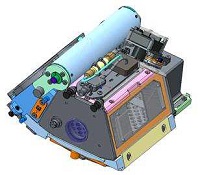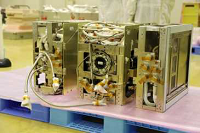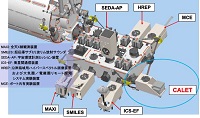Cargo in the Pressurized Logistics Carrier (PLC)
Utilization/experiment related items
Mouse Habitat Unit (MHU)--Kibo as a platform for aging studies
- Space is the only one environment where accelerated changes of aging such as bone loss, muscle atrophy, and immunological deterioration can be observed. To take advantage of the environment, Kibo is planned to be used as a platform for aging studies.
- Total 12 MHUs enables the separate observation of 12 mice for approximately 30 days.
- Can set two gravity conditions, microgravity and artificial gravity (1G, e.g.) at one time for comparison. Artificial gravity experiment of mammals on the ISS will be the first time in the world.
Electrostatic Levitation Furnace (ELF)
--A platform for the study of high temperature melts
- As liquid can stay levitated without the need of the container in microgravity, precise measurement of the thermophysical properties of materials with melting temperatures of over 2,000 degree C. is possible.
- The ELF is one of the world’s superior devices that can measure the thermophysical properties of high-temperature melts, covering metals to insulators.
- The objective of the ELF is to obtain unexploited thermophysical property data and compile a database and then contribute to the improvement of material processing and development of new functional materials by sophisticating casting and welding simulations.
Multi-purpose Small Payload Rack (MSPR-2)
--The next generation rack that realizes to conduct a variety of experiments
- The second rack of the Multi-purpose Small Payload Rack already installed to Kibo.
- The MSPR-2 is a rack for multi-purpose uses and provides power and communication interface to each experiment device installed to it.
- ELF will be installed to the upper part of MSPR-2, called the Work Volume (WV).
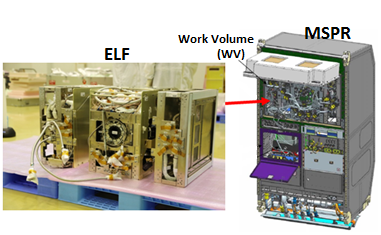
The image of the MSPR-2 and the ELF installation location
Exposed Experiment Handrail Attachment Mechanism(ExHAM-2)
--Enhancing the reliability of materials by conducting the durability demonstration for use in space
- An experiment device for conducting exposed demonstration and experiments using the Kibo’s airlock and robotic arm (JEM Remote Manipulator System: JEMRMS), without the necessity of performing Extravehicular Activities.
- This device makes it possible to attach and remove experiment samples easily and frequently. Samples can be returned to Earth for analysis for the researchers.
- This unique feature can be used by commercial companies and universities to study and assess the quality and reliability of new materials for use in space.
- KOUNOTORI5 will deliver experiment samples to be attached to ExHAM and ExHAM-2.
Small satellites (CubeSat)
Experiment samples
System supplies
- Pumps and filters of the Water Recovery System (WRS)
KOUNOTORI5 is loaded with the pumps and filters of the Water Recovery System (WRS) upon NASA’s urgent request and under an agreement. The supplies were airlifted to Tanegashima island in late July. They are the components of the WRS that generates drinkable water from distillated water of the crew's urine and condensate water collected from the air conditioner.
- Galley Rack
The Galley Rack will be installed to the Unity module (Node1) and located near the dining table of the US Orbital Segment. The Galley Rack is equipped with the potable water dispenser, food warmer, etc.
- Simplified Aid For EVA Rescue (SAFER)
The SAFER is a small thruster system for emergencies such as a case when an EVA member gets off the ISS during EVA, he/she can come back to the ISS with it. The SAFER is attached to the bottom of the Life Support System (LSS) on the back of Extravehicular Mobility Unit (EMU). As the SAFER is equipped with propellant (N2 gas), it is replaced regularly before the end of the operating life.
- Exposed Facility Power Distribution Box (EF-PDB)
EF-PDB is an electric power system and one of the Orbital Replacement Units (ORUs) on the Kibo’s EF. It is delivered in preparation for the fails.
Cargo for the ISS crew
- Food (retort pouches, dried food, fresh food)
- Potable water
- Crew's commodities
Cargo in the Unpressurized Logistics Carrier (ULC)
CALorimetric Electron Telescope (CALET)--Space radiation observatory as the forefront of space science
- In addition to the finding of the origin of high-energy cosmic rays, any unprecedented findings that may lead to the identification of dark matters are expected.
- This observation mission may yield a lot of worldwide discoveries by running a long-term. By accumulating data of agile radiation at the ISS, CALET contributes to the advancement of space science in our nation.
Waste disposal
The HTV undertakes a role of reentering into the atmosphere with up to 6 metric tons of waste and expired experiment devices that become no longer necessary, thereby enabling the removal and replacement of devices on the ISS. When KOUNOTORI5 departs from the ISS, it leaves with the followings aboard:
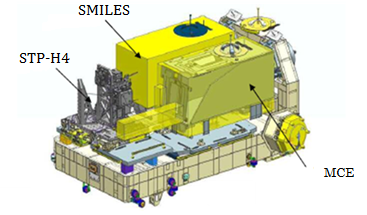
Waste cargo layout on the EP
- Superconducting Submillimeter-Wave Limb-Emission Sounder (SMILES)
- Multi-mission Consolidated Equipment (MCE)
- Space Test Program - Houston 4 (STP-H4)
A Japanese experiment device delivered aboard the HTV1 in 2009 and has been installed to the Kibo’s EF.
A Japanese experiment device delivered aboard the HTV3 in 2012 and has been installed to the Kibo’s EF.
A NASA experiment device delivered aboard the HTV4 in 2013 and has been installed to the ELC-1 on the truss. Meteorological observation, heat control, radiation measurement, and data processing test were conducted.

